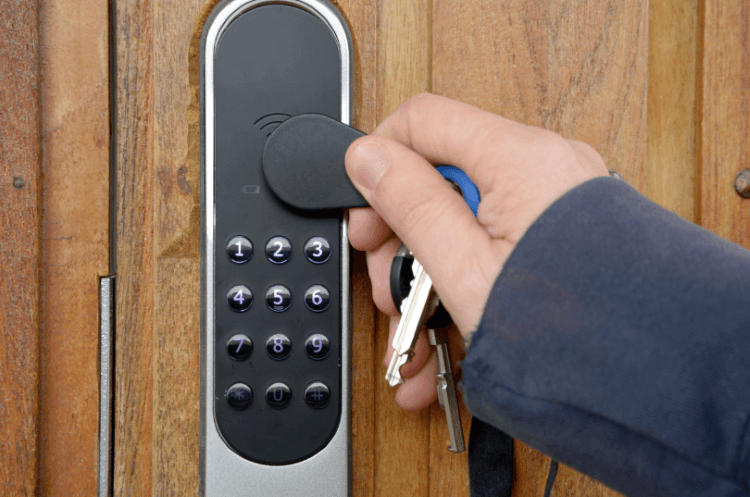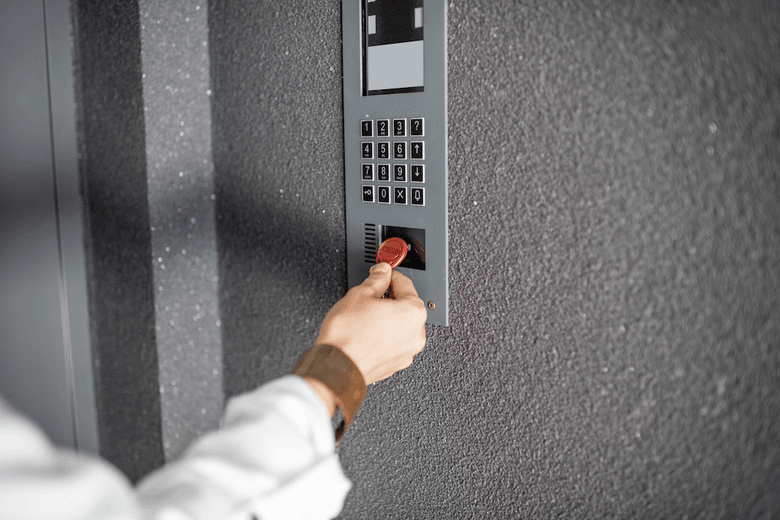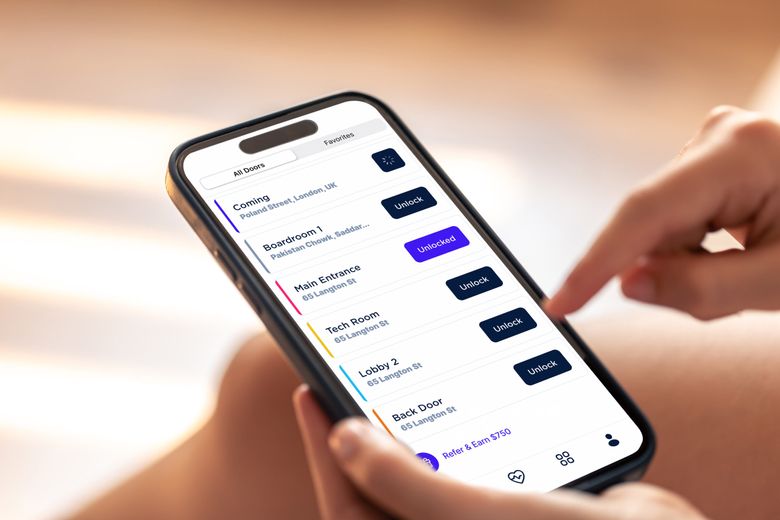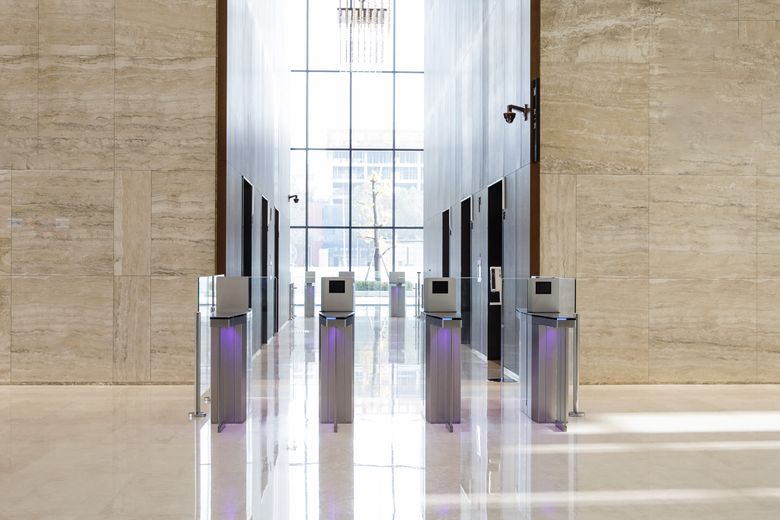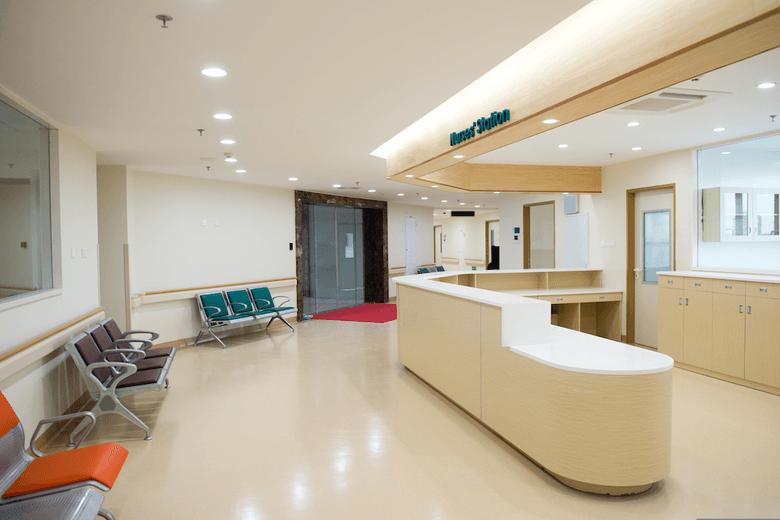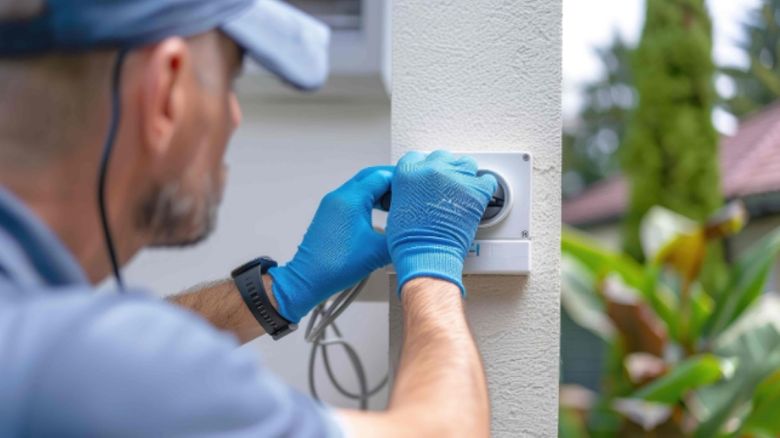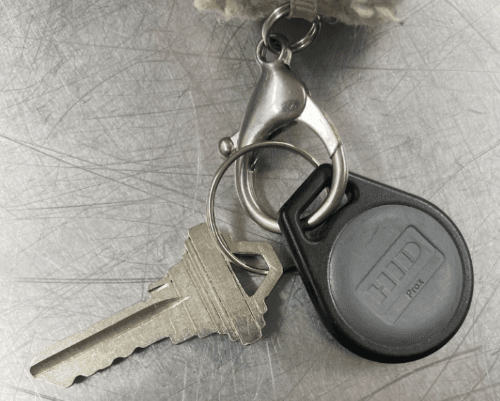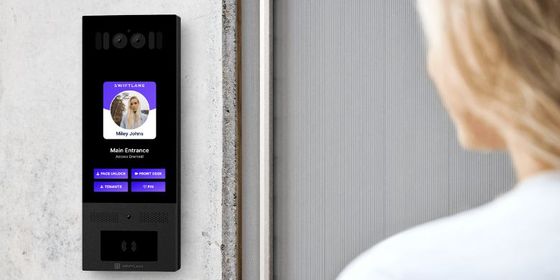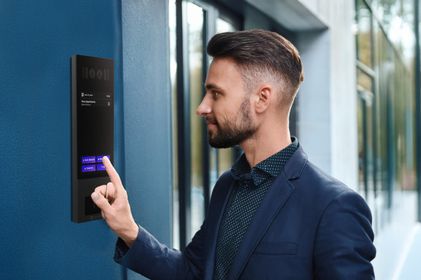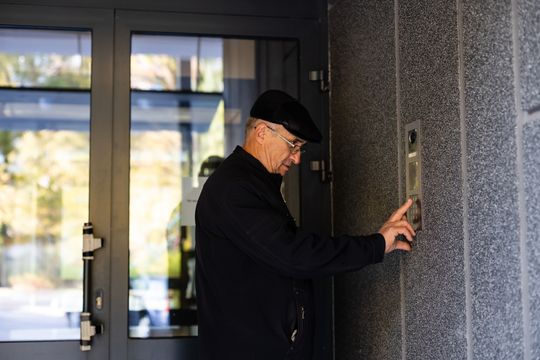Article Updated on March 28th, 2025
Here’s why you won’t find metal keys in commercial buildings anymore—they’re easy to duplicate and lack any form of access tracking. In contrast, key fob entry systems offer secure credential-based access to get in and out of a building, making them a widely preferred alternative for modern access control systems.
These wireless, contactless systems allow tenants, employees, and authorized personnel to authenticate by tapping a proximity reader to unlock doors instantly.
Moreover, unlike outdated key systems, key fob access can be centrally managed, monitored, and updated in real-time, giving property managers complete control over who can enter and when.
If you are considering installing a key fob entry system for commercial buildings, we have you covered! We provide need-to-know information about how the systems work and offer a high-level overview of a dozen key fob entry system providers.
Who this guide is for:
- Commercial real estate management companies are looking for whole-building solutions
- Tenants in commercial buildings who want to secure their floor, store, or office space
- Small and medium-sized companies looking for a new access control solution
- Facility managers of large campuses need enterprise-scale access control options that integrate key fob systems into holistic security systems.
Table of Contents
- Introduction to Key Fob Door Entry Systems
- Understanding How Key Fob Entry Systems Work
- Types of Commercial Key Fob Entry Systems
- Key Benefits of Using a Key Fob System
- Special Features to Consider in a Key Fob Entry System
- Types of Commercial Buildings That Benefit
- Assessing Your Commercial Property’s Needs
- Installation and Maintenance Considerations
- Top Providers of Proximity and Key Fob Access Control
- Conclusion: Making the Right Choice
Suggested Posts
- What is a Fob System and How to Choose One
- The Best Apartment Intercom Systems (2024)
- Best Apartment Call Box Systems – 2025
Introduction to Key Fob Door Entry Systems
A key fob door entry system is an access control method that lets you unlock doors using a wireless credential (enabled through radio frequency) instead of a traditional key. These credentials can come in different forms, such as fobs (small, keyring-sized devices), ID cards, and RFID stickers.
Fobs work the same way as tap-to-pay credit cards and mobile wallets. Holding or tapping your fob near a reader wirelessly communicates with the system to unlock the door.
Understanding How Key Fob Entry Systems Work
A key fob credential contains an embedded RFID chip and antenna. The chip stores a unique identification number as a digital “key.” When the key fob or card is brought close to a proximity reader, the reader emits a radio frequency (RF) signal.
This signal powers the radio frequency identification (RFID) chip, enabling it to transmit its unique ID to the reader. The reader receives the ID and sends it to the access control system, a centralized database that manages the permissions for each RFID chip, checking if it is authorized for entry.
Some credentials use a particular type of RFID called near-field communications (NFC). Other newer systems may forgo RFID altogether and use a two-way radio technology called Bluetooth low energy (BLE).
RFID vs. NFC
NFC is more versatile and allows for secure, two-way communication, but it only works to a few inches between the device and the proximity reader. Ordinary RFID only permits one-way communication, is somewhat less secure (it can be copied), and works from a distance of several feet.
NFC vs. BLE
Like NFC, BLE can include secure two-way communications. With its extended range, BLE is used in scenarios where convenience and flexibility are prioritized, such as using a smartphone to unlock doors without needing to be next to the reader. BLE is common in mobile phones, wearable tech, and Internet of Things (IoT) devices.
Many modern access control systems combine these technologies to enhance security and convenience. For example, a system might use BLE for initial detection as the user approaches the door and then require NFC for final authentication at the door.
Types of Commercial Key Fob Entry Systems
Choosing the right kind for your commercial property is crucial, as it can make or break your security setup. We’ve compiled a list of the most popular types to help you make an informed decision!
Proximity Key Fobs
With RFID as the backbone, all you need to do is wave or tap the fob near a corresponding reader, and voilá – the door unlocks! Here are some key benefits:
- Effortlessly secure: No need to remove it from your pocket or bag.
- Highly customizable: The access range can be adjusted based on your needs.
- Employee tracking: Some such systems can track employees across an entire facility, which can help log time sheets or keep tabs on essential personnel, such as actors in a hospital.
Smart Key Fobs
Upgrade your security with smart key fobs that rely on Bluetooth Low Energy (BLE) or Near Field Communication (NFC) technology. These cutting-edge devices offer even more convenience and extra perks:
- Mobile app integration: Manage access through smartphones.
- Two-factor authentication: This type of key fob system enhances security with additional verification steps, providing an extra layer of security against lost or stolen credentials/ hacking.
Biometric Key Fobs
For top-notch protection, consider biometric key fobs, which incorporate fingerprint scanning technology in addition to the traditional keyless access control system granted by the fob.
- Added security layer: This restricts access to unauthorized individuals. Even if a key fob is lost or stolen, it can only be used by its assigned user.
Key Benefits of Using a Key Fob System
Commercial key fob door entry systems provide the following advantages:
No Fumbling Around
You won’t waste time finding the right key on your key ring. Just wave or tap the fob, badge, or phone near the reader. With some systems, you can leave your credentials in your purse, wallet, or pocket, just like with many car keys today.
No PINs
Building tenants don’t need to remember numerous pins for front doors, bathrooms, or other campus facilities, and building management doesn’t need to manage unique pins for each user or entry point.
Cover Multiple Entry Points
Like most keys, you can repeatedly use a single radio-enabled key fob at multiple entry points, such as a driveway gate, building entry, internal gate, storage room door, bathroom door, etc. There is no need to carry multiple keys.
Enhanced Security
Unlike traditional keys, you cannot easily copy most key fobs at the hardware store, especially systems offering encryption like NFC and BLE credentials.
Importantly, you can remotely deactivate a key fob, such as when an employee is terminated, without needing to change the locks.
Overhead Savings
Giving tenants and employees this self-service tech can save on operational costs for receptionists and building security.
Modernize Visitor Management
Many key fob door systems integrate visitor management tools and gates at elevator banks, letting you say goodbye to sign-in books, long waiting times, and frustrated visitors. Assign temporary key fobs to guests and track them if needed.
Improved Tracking and Timekeeping
Key fobs have unique codes, so building owners or company management can pinpoint people behind all access events, which can’t be done with metal keys. Some RFID key fob systems allow all employees to be tracked across an entire facility in real time, which can be critical in intensive care facilities.
Future-Proof
Software updates and replacement key fobs, such as those with fingerprint capabilities, allow you to leverage your existing system and door infrastructure and augment its capabilities over time.
Integration Capabilities
Many key fob door entry systems integrate with other technology, including cloud-based management tools, facial recognition, telephone call boxes, video intercoms, residential gates, and security camera systems, providing a comprehensive access control solution.
Special Features to Consider in a Key Fob Entry System
Today, mobile apps for controlled access systems and facial-recognition intercoms provide tools that let busy workers unlock doors on the go without old-fashioned keys.
Mobile App Integration: Smart and Accessible
Using smartphone apps’ remote capabilities to manage key fob systems offers users a wealth of benefits.
- Remote Management: You can control door access directly from your smartphone, even when you’re off-site. Such apps also integrate well with video intercom systems.
- Instantaneous Updates: Authorize new users, change access levels, and revoke permissions with a phone tap.
- Real-time Notifications: Stay informed with instant notifications of door access events and view a live video feed remotely from your phone.
- Detailed Reports: Monitor access logs and view helpful reports on the go.
Face Unlock: Futuristic and Secure
Step into the world of biometrics with facial recognition unlock technology for next-level commercial space security, like:
- Hands-free Access: Need both hands to carry stuff? No problem—your face grants you access.
- Unique Biometric Authentication: Every person’s face is unique, making face unlock a highly secure access method. There is no need for fingerprint key fobs.
- Eliminates Lost or Stolen Fobs: No more hassles of replacing misplaced fobs or worrying about stolen access cards.
By adopting modern, keyless entry options like mobile app integration and face unlock, you’ll be at the forefront of security advancements while ensuring a user-friendly, convenient experience for staff and tenants.
Types of Commercial Buildings That Benefit
Every building can reap the benefits of commercial key fob door entry systems; you must match the right system to the building’s unique requirements. Let’s explore the types of commercial spaces that benefit and what they can expect with a well-designed key fob access control system here.
Offices
Key fob access is perfect for offices with multiple departments, restricted areas, or long working hours. However, even a basic system can create simplicity and convenience for a small office with a single door. Implementing key fob access for offices can:
- Optimize security and privacy for different teams
- Ensure employee and visitor safety
- Simplify after-hours and weekend access management
- Reduce costs on front desk security and reception personnel
Retail Establishments
Keeping inventory secure and managing staff access to restricted areas is vital for retail locations. Key fob systems provide:
- Enhanced security for stockrooms and offices
- Smooth access control for employees and deliveries
- Peace of mind for business owners
Healthcare Facilities
Maintaining a sterile environment and patient privacy in healthcare facilities is non-negotiable. Healthcare facilities are uniquely responsible for maintaining patient confidentiality according to the Health Insurance Portability and Accountability Act (HIPAA). Key fobs help:
- Safeguard restricted zones like drug storage or patient wards.
- Monitor access to sensitive areas.
- Get medical staff where they need to be, using their ID badge to open doors.
- Provide a user authentication tool to secure computer terminals and digital patient record systems, limiting them to authenticated users with a key fob or RFID identity card.
- Track where critical personnel are located across a facility.
Industrial Warehouses and Facilities
Secure access is crucial for industrial buildings where expensive equipment and materials or dangerous substances are stored. Installing key fob access can:
- Protect valuable assets and prevent theft
- Ensure only authorized personnel enter
- Facilitate access for shift workers and deliveries
- Double up as a time-card system for logging worker hours
No matter the type of building, commercial key fob door entry systems and mobile access control systems can significantly enhance security, convenience, and overall management. Assess your unique requirements and invest in a tailored key fob solution for unbeatable efficacy.
Assessing Your Commercial Property’s Needs
With systems ranging from a single point of entry to those that manage thousands of doors, figuring out your building’s needs, choosing the right system, and installing it can be a considerable challenge. Generally, you can outsource this entire process, except maybe the most straightforward single-door installations. However, it can speed up the process if you prepare some general information before you contact a key fob entry system provider.
Assess Security Needs Per Space
Not all spaces within a building are created equal. To make optimal use of your key fob system, prioritize securing different areas according to their sensitivity.
- Create a list of zones within the building (e.g., the central office, server room, storage areas, etc.).
- Assign access levels based on each zone’s importance. Do your security needs require two-factor authentication or biometric identification built into the system?
- Customize your key fob system to match these requirements.
Consider Scalability
As your business grows or tenants change, ensure your key cards and system can adapt.
- Opt for a solution that supports numerous key fobs and doors, or scale according to your personnel and facility growth plans.
- Check that your system can integrate with related technology, including building lobby gates, video intercoms, or vehicle gate systems.
Plan for a Successful Installation
Installing a commercial key fob door entry system doesn’t have to be a headache. Nail down the details beforehand and share these with your provider.
- Map out the building and determine door access points that require key fob integration.
- Work closely with the installation team to minimize disruption. See if it can be installed across multiple doors in sequence so that there is always an unencumbered entrance during the installation process.
- Set clear timelines and expectations for completion.
Train Staff, Tenants, and Users
Ensure all relevant parties know how to use your key fob entry system.
- Educate staff and users on system functionality and benefits
- Provide hands-on training on using key fobs and accessing secured areas
- Establish clear protocols for handling lost or damaged key fobs
Considering these factors, you can successfully transform your commercial space’s security and enhance user experience with a streamlined key fob system.
Installation and Maintenance Considerations
Here’s a quick rundown of the expenses you can expect on this security-enhancing journey of installing commercial key fob door entry systems for buildings.
Initial Installation Costs
The cost of installing a key fob system varies depending on factors like system type, number of doors, and additional features.
- Key fobs: Typical credentials, such as key fobs or ID badges, cost between $10 and $50 per user.
- Basic systems: A single-door setup with a straightforward credential proximity reader, including installation, costs $1,000. Individual proximity readers (hardware only) cost a few hundred dollars.
- Advanced systems: Fully integrated solutions, including a video intercom system, can cost up to $5,000 per door. These systems are typically used at main entrances, not interior doors.
Remember to factor in labor costs for installation, which can vary by location and complexity. Per-unit prices can drop when you install many components across a large facility with numerous entry points and internal doors and the work is done simultaneously.
Recurring Services Expenses
While key fob systems have relatively low maintenance requirements, it’s crucial to budget for ongoing costs like:
- Software updates: Stay secure with the latest version, which may require periodic subscription fees
- Professional maintenance: Schedule annual system check-ups with a pro for optimal performance
- Cloud-based platforms: Many key fob systems are sold under a software-as-a-service (SaaS) model, in which you pay a monthly per-user fee, generally a few dollars per user, for a cloud-based management platform. Prices typically fall as more users are integrated into the system.
Long-Term Savings
While it may require upfront investment, key benefits of fob systems can lead to long-term savings:
- Significant reductions in unauthorized access
- Fewer instances of theft, vandalism, or losses
- Improved tenant satisfaction and retention
- Reduced overhead: Go without full-time reception or security staff and use a virtual receptionist for guests at a fraction of the cost of a full-time person.
While installing and maintaining a key fob system might initially seem daunting, the long-term benefits and security enhancements make it a worthwhile investment for your commercial building.
Top Providers of Proximity and Key Fob Access Control
Numerous companies manufacture key fob door entry systems for commercial buildings. Some are geared toward scalable, networked systems for large enterprises, while others focus on simplicity and a streamlined product lineup for small and medium-sized enterprises.
Below, we provide a brief overview of major brands to consider. You can also read our more extensive review of the best commercial key fob door entry systems.
1. Swiftlane
Swiftlane specializes in cloud-based access control systems with video intercoms for mid-size workplaces and multi-family residential buildings.
Their systems integrate key fob, mobile, and facial recognition access control to provide flexible and scalable security solutions.
Major reasons to consider Swiftlane are their modern product lineup, built-in facial recognition capabilities, and intercoms featuring sleek, contemporary designs.
2. Paxton
Paxton offers versatile access control solutions that can scale to very large facilities. They cater to small to large commercial buildings and feature a wide range of proximity readers, which support key fob entry, mobile credentials, and integration with video surveillance.
They also provide entry panels, wireless door handles, and management software. Paxton is a good choice if you have numerous types of entry points and need a system that can grow to include up to 1,000 doors and security cameras.
3. CDVI
CDVI focuses on access control solutions with a strong emphasis on security and user IDs. They cater to various facilities, including the education market, offering systems tailored to specific security needs for a standalone facility or an entire campus.
A key product in their lineup is TAG-EV2 wearable identity card necklaces for tapping at proximity readers. The company offers dozens of models of proximity readers, including those with keypads for PIN-based entry. This company is one to consider for large-scale institutions and campuses where up to 10,000 users may need access credentials.
4. Kantech
Kantech, part of Tyco Security Products, provides reliable and scalable access control solutions that are easy to install and manage.
It focuses on serving small businesses and large enterprises. Kantech’s key fob systems are part of its broader access control offerings, which can be integrated with products from other Tyco Security brands.
5. HID Global
HID Global is a behemoth in access control. It offers a wide range of products, including key fobs, smart cards, and mobile access solutions, designed for businesses that require advanced, scalable access control.
A key offering of their systems is the ability for smartphones to function as key fobs, and multi-factor authentication options like biometrics. They offer cloud-based services for large enterprises, such as healthcare facilities, enabling tracking of employees across a facility at any time.
6. Doorking
Doorking specializes in telephone call box entry systems for gated communities, parking garages, and commercial buildings, strongly emphasizing durability and ease of use.
If you want to use a traditional telephone-based call box as the building intercom, this may be the brand to turn to for key fob access control. Doorking also has RFID tags that can be attached to cars to automatically open gates to a property or facility.
7. Lenel-S2
Lenel is a leader in enterprise-level access control solutions, providing high-security systems for large commercial and government buildings and campuses. They focus on integrating access control with other security systems, such as video surveillance and intrusion detection.
Lenel’s OnGuard platform includes highly customizable and scalable key fob entry systems. It supports various access control technologies, including biometrics and mobile credentials. The company also offers numerous online management platforms for tracking data and gaining insights.
8. Genetec
Genetec is a service provider offering unified security solutions that integrate access control, video surveillance, and license plate recognition using products from various manufacturers.
Genetec’s Synergis platform includes key fob entry systems as part of a broader security management solution. The platform supports various access control technologies, including mobile and biometric credentials.
9. Honeywell Prowatch
Honeywell’s Prowatch is an enterprise security management system with key fob entry systems as part of its access control offerings. Honeywell specializes in providing premium-priced, comprehensive security solutions for large organizations.
10. ProDataKey (PDK)
PDK focuses on its PDK.io cloud-based access control solution. Its systems are designed to be easily managed remotely, offering significant advantages for businesses that require scalable and adaptable security solutions.
PDK’s key fob entry systems are noted for their integration capabilities with other security technologies. The company offers various credential products for mobile phones, key cards, fobs, stickers, and wristband devices.
11. IdentiSys
IdentiSys is renowned for providing comprehensive key fob access control systems using plastic card identification. Using RFID technology, the company can provide various tracking capabilities for employees and critical inventory.
IdentiSys offers solutions tailored for multiple sectors, including healthcare, education, and government. It also integrates key fob systems with video surveillance and visitor management systems, making it a holistic security provider.
12. Avigilon (Alta)
Avigilon is a leader in comprehensive security solutions, including keyfob-based access control, security cameras, and other building sensors. It emphasizes real-time remote cloud-based management and end-to-end encryption, making its systems highly reliable and secure.
Avigilon’s systems are known for their scalability, making them ideal for both small and large-scale commercial properties. They also offer cloud-based management options, which are increasingly popular for remote monitoring and control.
13. Giesecke+Devrient (StarSign)
Giesecke+Devrient stands out for its biometric key fobs, which include a fingerprint reader and use an encrypted authentication system called FIDO. G+D uses a subscription model in which users pay for ongoing access to the authentication service delivered over the cloud. There is a per-user fee for each key fob. The pricing of the systems depends on the number of users.
Conclusion: Making the Right Choice
We’ve outlined the numerous ways commercial key fob door entry systems can bring added value and convenience to your property.
From improved security and employee satisfaction to efficient visitor management and future-proof technology, a well-chosen key fob system is a game-changing investment for any commercial building.
Consider the following checklist before purchasing commercial key fob door entry systems.
- Assess your commercial building’s unique requirements and match them to the correct key fob type. Talk with various providers about what system might suit your needs.
- Prioritize the must-have features for enhanced security, convenience, and seamless integration.
- When developing your budget, consider installation and ongoing service fees and balance those against the potential long-term savings from reducing overhead. A key fob system usually saves you money in the long run.
- Consider the convenience of selecting modern keyless options, such as mobile app control and facial recognition unlock technology, as part of a key fob door entry system.
- Integrate visitor management services to offer a streamlined guest experience, particularly in buildings with high foot traffic.
- Consider a cloud-based management system for remote accessibility and reduced operating costs.
If you’d like to learn more, our key card access control page may be the next place on your journey.
Get a Quote
Please share more details about your building so we can find the perfect solution for you!

